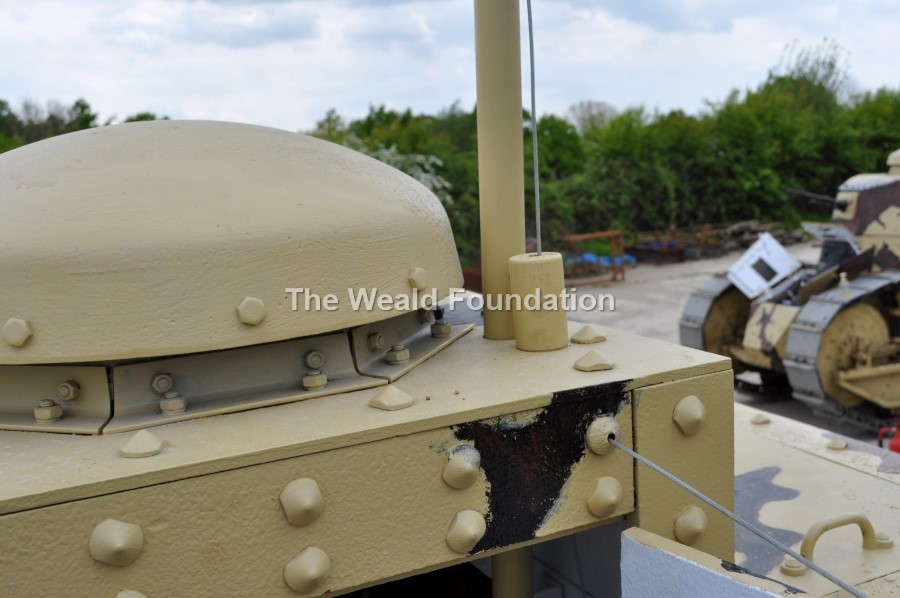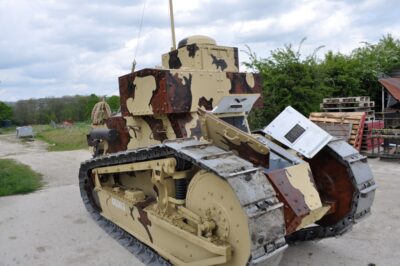WW1 saw many innovations in military science, not least in the area of communications. The tank evolved out of the need to restore mobility to the battlefield. The French Renault TSF (te’le’graphie sans fil) evolved to meet the need to communicate once mobility was restored.
The possibility of restoring a working Renault TSF ‘tank’, with its box-like communications Blockhaus turret, arose as we sourced parts for our Renault FT char leger. General Jean Baptiste Estienne ordered 200 in January 1918. This was increased to 300 in April 1918. Approximately 180 were finally produced but less than 50 were accepted by the French War Office during WW1 and half as much accepted by the Artilllerie Speciale units themselves. The Renault TSF is a much rarer but as historically important type of vehicle, when compared to the Renault FT.
Most collectors find this vehicle intrinsically less interesting, as it does not have a gun. This has resulted in many Renault TSFs being altered to the FT configuration. The Blockhaus superstructure is replaced with a revolving turret equipped, with either a machine gun or Puteaux 37mm cannon. The consequence of this action causes the loss of history and rich provenance. Physical evidence is often altered or obliterated.
However after a considerable period of time, we located the basis of a TSF hull. This Renault TSF hull surprisingly retained the remnants of many of its original features and components.
Restoration of any of our vehicles, starts with an initial survey shortly after it arrives. Detailed research is then carried out over time and further parts and components will be added. Unfortunately, due to the age of the Renault TSF some of the required parts were simply not available. The research and accumulation of the research material to assist us in the identifying and dimensioning components, turned this project into a time-consuming challenge. The physical work on both the Renault FT and TSF started in 2014. A deadline was set for May 2018 in time for various WW1 commemorative events set for 2018.
We located substantial sections of the Blockhaus internal components over time - radio operator’s seat frame and cover, the radio operator’s table frame and hinges, the commander’s seat and frame and many other unique parts. The camouflage on the Renault TSF body armour panels located were in far better condition than those of the Renault FT but the registration number was more tricky to identify than on the Renault FT.
All plates were carefully examined and recorded before being stored. This process has to be done carefully but swiftly as prolonged exposure to light can cause markings and paint to fade or disappear completely.
The Renault TSF plates were added to the list of items to be analysed by the Crick Smith/Lincoln Conservation. The Institute is regarded as one of the world’s leading historic materials conservation consultancies, specializing in historic paint analysis and paint research.
Although the front plate of the Renault TSF was in much better condition than the FT, only three numbers were initially decipherable. These were 668.... The assembly number was retrieved from the two front drivers hatches after the annealing process. A very distinct 013 was clear to see which ties in with the registration numbers. The 13th Renault TSF to leave the assembly line - an early TSF assembled and approved before November 11 1918. Our TSF was very likely accepted by the army. The unit that received it and whether it saw action is still unknown.
The work on the Renault TSF was carried out alongside the Renault FT. Although there were a number of differences between the two vehicles, tasks that required machining or casting of components that are similar such as the radiator, could be produced at the same time.
We focused on items that were specific to the TSF, including the radio. A specialist who owned an original ER 10 who had recently recreated the Marie Curie Laboratory in Paris made an exact copy of the radio case using the original oak and ebonite. The small items such as switches were sourced as originals or cast and made to exacting specifications. The method of opening the radio to access the interior was reproduced but no interior was to be provided. This was our decision as there was no foreseen benefit of having a working radio within the Renault TSF.
We began our Renault TSF project knowing nothing about the interior of the vehicle, save for a basic loading plan schematic found in one of the manuals. The discovery of a second turret gave a us more insight into the interior detail. It contained the remains of the antenna reel base and the mount, together with a number of fixings. However there remained many unknowns such as the antenna reel and handle dimensions.
As so often happens in our projects, once the restoration was finished new information came to light. We received a series of original blueprints and archive documents from April and May 1918. These described exactly how the antenna reel, the mount and stay mechanism and the antenna mast top and pulley were designed. All of these items were actioned and fitted to the interior of the Renault TSF.
- This article has 859 words
- Reading time: 4 minutes
- There are no photos
Become a Member - Access the Full Article
Members gain access to the full content of our articles, including photo galleries.


